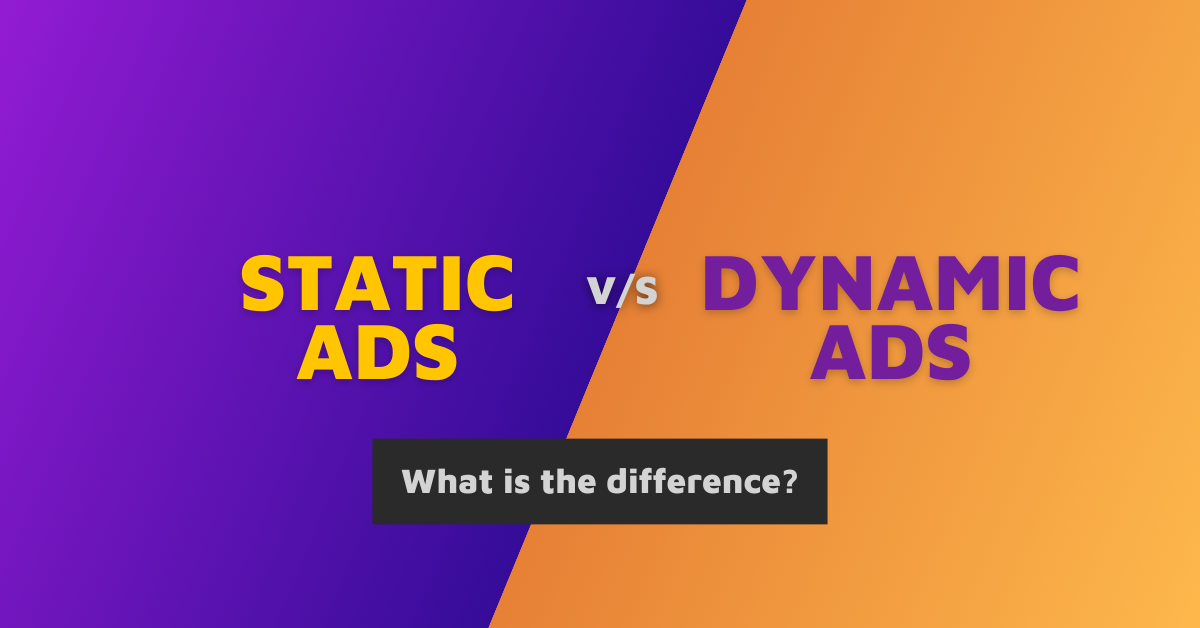Static vs Dynamic Ads – Detailed Comparison
In the ever-evolving landscape of digital advertising, a fierce feud rages between two distinct giants: static and dynamic ads. These two formats, each with its own arsenal of strengths and limitations, have carved out their niches in the advertising world. As the digital environment continues to transform at a breakneck pace, the question arises: which of these adversaries should rightfully claim the throne as the preferred advertising strategy?
Static ads, reminiscent of traditional advertising, rely on fixed images or text to convey messages. They offer a sense of brand consistency and cost-effectiveness that has stood the test of time. On the other side of the ring, dynamic ads, armed with interactivity and real-time adaptability, engage users on a deeper level and cater to personalized experiences.
In this blog, we embark on a journey to dissect the intricate battle between static and dynamic ads.
What are statics ads?
Static ads are a type of ad format characterized by fixed visual elements, such as images or text, that do not change during the duration of their display. They offer a reliable and unchanging presentation, differentiating them from their dynamic counterparts. For advertisers and publishers, understanding static ads is pivotal in crafting an effective advertising monetization strategy.
Static ads prioritize simplicity and cost-efficiency, making them an appealing choice for advertisers seeking to maintain brand consistency or convey straightforward messages. These ads maintain a static appearance throughout their display, lacking the dynamic, interactive features seen in dynamic ad formats.
However, as the digital advertising landscape evolves, it’s crucial for advertisers and publishers to recognize that static ads may not always deliver the desired CTR, engagement levels or personalization that dynamic ads can offer. The decision between static and dynamic ads hinges on various factors, including campaign objectives and target audience preferences.
What are the types of static ads?
There are several different types of static ads, each designed to serve specific advertising goals and formats. Here are some common types of static ads:
- Banner Ads
Banner ads are one of the most well-known forms of static advertising. They are typically rectangular or square in shape and appear at the top, bottom, or sides of web pages. Banner ads often contain static images or text and are used for various purposes, including brand promotion, product advertising, and CPC campaigns.
- Display Ads
Display ads encompass a broader category of static advertisements that can include banners, rectangles, squares, and other ad formats. They are commonly used across websites, social media platforms, and as in- app ads to visually promote products, services, or content.
- Text Ads
Text ads are simple static advertisements consisting of plain text. These ads are commonly used in search engine advertising, like Google Ads, where advertisers bid on specific keywords to have their text ads displayed alongside relevant search results.
- Interstitial Ads
Interstitial ads are full-screen static ads that typically appear between content transitions, such as during mobile app launches or when navigating between web pages. They often serve as splash screens or promotional messages before users access the intended content.
- Rich Media Ads
While not purely static, rich media ads can incorporate static elements alongside interactive features like videos, animations, and clickable components. These ads aim to provide a more engaging experience while still retaining static elements for branding or messaging.
- Sponsored Content
In some cases, static ads can take the form of sponsored content within a webpage or article. These ads blend seamlessly with the surrounding content and are intended to appear as a natural part of the page.
- In-Image Ads
In-image ads are static ads that are overlaid onto images within web content. These ads are designed to be non-intrusive and are often used to provide additional information or links related to the image.
The choice of which type of static ad to use depends on the advertising goals, target audience, and the platform where the ad will be displayed. Each type has its own strengths and is suited to different contexts within digital advertising.
What are dynamic ads?
Dynamic ads represent a dynamic and interactive form of online advertising. They differ from static ads in that they can change in real-time based on various factors such as user behavior, preferences, location, or other dynamic data inputs. These ads aim to create a highly personalized and engaging experience for the viewer.
Dynamic ads have evolved in response to the growing need for advertisers to deliver more relevant and customized content to users. They have their roots in the concept of contextual advertising, where ads are tailored to the content or context of a webpage.
Over time, advances in technology and data analytics have enabled advertisers to take personalization to the next level, giving rise to dynamic ads that can adapt in real-time to deliver the most relevant message to each user.
What are the types of dynamic ads?
There are different types of dynamic ads, each tailored to specific advertising goals and platforms. Here are some common types of dynamic ads:
- Dynamic Display Ads
Dynamic display ads, also known as personalized display ads, adapt their content and visuals based on the user’s behavior, browsing history, or demographic information. These ads aim to deliver highly relevant content to each viewer, increasing engagement, conversions, and other important metrics.
- Dynamic Product Ads (DPAs)
DPAs are commonly used in e-commerce and retail. They automatically showcase products that a user has previously viewed or shown interest in, encouraging them to complete a purchase. DPAs dynamically pull product images, descriptions, and prices from a product catalog.
- Dynamic Remarketing Ads
Dynamic remarketing ads target users who have visited a website or app but did not complete a desired action, such as making a purchase. These ads display specific products or content that the user viewed during their previous visit, reminding them of what they left behind.
- Dynamic Search Ads (DSAs)
DSAs are designed for search engine advertising. They automatically generate ad headlines and landing pages based on a website’s content and user search queries. DSAs are particularly useful for websites with a large inventory or frequently changing content.
- Social Media Dynamic Ads
Platforms like Facebook and Instagram offer dynamic ad formats that can automatically create and display personalized ads to users based on their interests, behaviors, and interactions on the platform. These ads often promote products or services tailored to individual users.
- Email Dynamic Content
In email marketing, dynamic content can personalize email messages by including dynamic product recommendations, location-specific information, or personalized greetings. This type of dynamic ad aims to increase engagement and conversions through personalized email communication.
- Video Dynamic Ads
Dynamic video ads adapt video content in real-time based on user data and preferences. They can include personalized product recommendations, tailored messages, or interactive elements to enhance user engagement.
- Native Advertising
Native advertisements can be dynamic by adapting their content to the context and layout of the platform where they are displayed. They blend seamlessly with the surrounding content, providing a personalized and non-disruptive user experience.
These different types of ads leverage real-time data and user insights to deliver customized content and enhance user engagement. The choice of which type to use depends on the specific advertising objectives, target audience, and the platform or channel where the ads will be displayed.
What is the difference between static ads and dynamic ads?
Static and dynamic adsboth htold their own features and advantages taht are beenfitcial for adverting. Here is a detailed difference between the two
Static vs Dynamic ads
| Static Ads | Dynamic Ads |
| Static ads are characterized by their fixed content, typically consisting of unchanging images or text. These ads do not adapt or interact with users in real-time. | Dynamic ads are interactive and adaptable. They can change their content in real-time based on various factors, such as user behavior, preferences, or location, providing a more personalized experience. |
| Static ads are known for their cost-effectiveness, as they involve the creation of fixed content that does not require frequent updates or dynamic elements. | The production costs for dynamic ads are generally moderate to high. These ads often require ongoing content updates, technical expertise, and data integration, which can increase costs. |
| Static ads excel in maintaining brand consistency, as their content remains unchanged. Advertisers can rely on them to deliver a uniform brand image. | Brand consistency in dynamic ads can be more challenging to achieve, as the content is adaptable. Careful management is necessary to ensure brand identity remains intact. |
| Static ads offer limited interactivity and user engagement. They rely on the appeal of static visuals and text to capture the audience’s attention. | Dynamic ads provide enhanced user engagement through interactivity and real-time content updates. They offer a more personalized and engaging user experience. |
| A/B testing options are limited for static ads because their content is fixed. Making changes for testing purposes can be cumbersome. | Dynamic ads allow extensive A/B testing and optimization opportunities. Advertisers can experiment with different content variations in real-time to determine what works best. |
| Static ads do not have real-time updating capabilities. Once created and deployed, their content remains the same until manually changed. | Dynamic ads can change their content in real-time, making them ideal for delivering up-to-date information, promotions, or personalized recommendations based on user data. |
| Static ads may be less affected by ad blockers since they typically consist of standard image or text elements. | Dynamic ads may face challenges due to ad blockers, as they often rely on scripts and data feeds to function, making them more susceptible to being blocked. |
| Static ads offer limited targeting options, often relying on the context of the webpage or platform for placement. | Dynamic ads provide extensive targeting options based on user behavior, preferences, and real-time data. Advertisers can deliver highly relevant content to specific audience segments. |
| Static ads are quick and easy to create since they involve fixed content that does not change frequently. | Dynamic ads may require more time for content generation, especially when integrating real-time data and ensuring content remains current and relevant. |
| Static ads are cost-effective for delivering fixed content with minimal ongoing expenses. | While dynamic ads may involve higher initial costs, they have the potential for a higher return on investment (ROI) due to their ability to deliver personalized content and real-time updates. |
| Static ads are commonly found in traditional advertising media and on informational websites. | Dynamic ads are prevalent in e-commerce, real-time promotions, and industries where personalized content delivery is crucial, such as travel and entertainment. |
What factors should you consider to choose between static and dynamic ads?
When determining whether to employ dynamic or static ads for your advertising campaign, several critical factors should be considered to ensure your choice aligns seamlessly with your specific objectives and target audience. These factors provide a comprehensive overview of the decision-making process:
- Campaign Objectives
The foremost consideration involves defining your campaign’s objectives. Are you seeking to establish brand awareness, drive conversions, enhance engagement, or deliver personalized content? Your choice between dynamic and static ads should be in direct accordance with these goals.
- Target Audience
Understanding your target audience is fundamental. Delve into their preferences and behaviors. Are they more inclined towards engaging with interactive and personalized content, characteristic of dynamic ads, or are they likely to respond favorably to concise and static messaging?
- Content Flexibility
The frequency at which your content requires updates is paramount. If your campaign necessitates real-time content adjustments to remain relevant, dynamic ads are the apt choice. In contrast, static ads excel in scenarios where consistent branding and messaging are pivotal.
- Production Resources
The resources at your disposal, including budget and creative assets, are influential factors. Dynamic ads may demand a more substantial budget and a level of technical expertise for content creation, adaptation, and management.
- User Engagement
Consider the level of engagement you aspire to achieve. Dynamic ads, through their interactivity and personalized content, are designed to engage users more deeply. Static ads, on the other hand, offer a more passive form of content consumption.
- Ad Placement
Contemplate the platforms and placements where your ads will appear. Some platforms and spaces may be better suited to dynamic or static ads based on their design and functionality.
- Budget and Returns
Carefully evaluate your available budget and assess the potential return on investment (ROI) or return on ad spends (ROAS) for each ad format. While dynamic ads may entail higher initial costs, they often offer superior ROI due to their personalization capabilities.
- Ad Blocker Considerations
Be mindful of the prevalence of ad blockers and their potential impact on your ad campaign. Static ads may have a lower susceptibility to ad blockers, whereas dynamic ads may require strategies to navigate this obstacle.
- Creative Assets and Generative AI
Generative AI can play a pivotal role in dynamic ad campaigns by automatically generating personalized content, images, and messages in real-time, reducing the reliance on pre-existing creative assets.
The decision between employing dynamic or static ads, or even embracing a hybrid approach, is a pivotal one that requires a comprehensive evaluation of multiple factors. Advertisers and publishers must carefully consider their campaign objectives, target audience preferences, content flexibility, available resources, and the level of user engagement they aim to achieve.




Leave a Reply